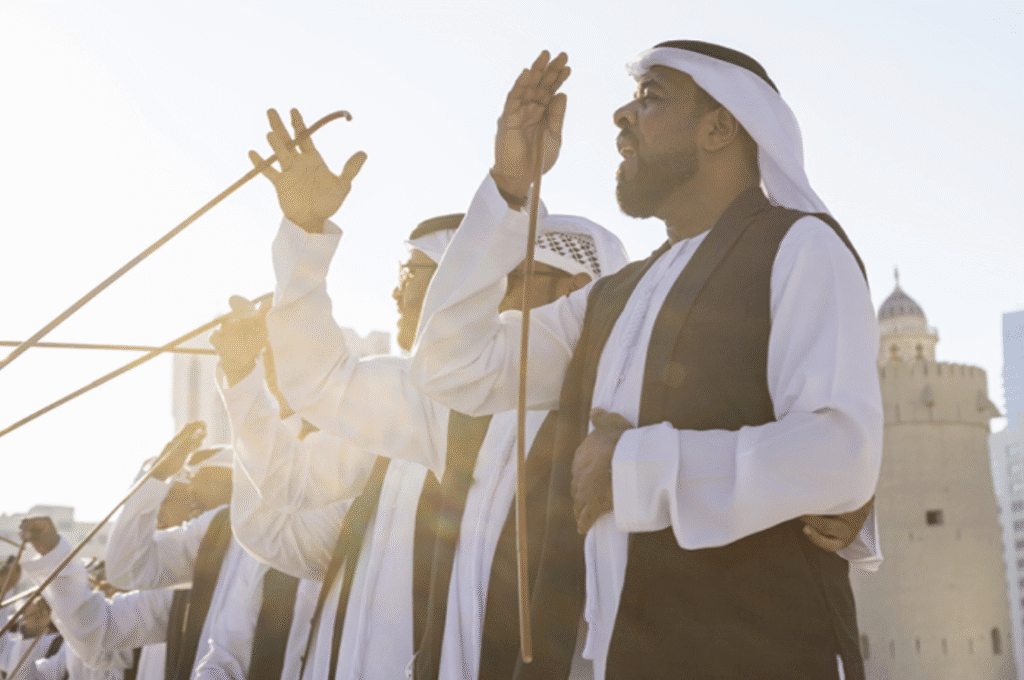A Dance That Tells a Story
The Al-Ayyala dance is one of the most iconic and meaningful traditional dances in the United Arab Emirates. Deeply rooted in Emirati Heritage, this performance is more than just a dance—it’s a symbol of unity, strength, pride, and honor. Known for its powerful rhythm and graceful movements, Al-Ayyala continues to play an important role in national celebrations, weddings, and official state ceremonies.
Passed down through generations, this dance reflects the strong tribal and Bedouin values that shaped the UAE. It showcases the spirit of brotherhood, courage, and unity, especially during moments of pride and patriotism. Whether performed in remote villages or during grand state events, the message of Al-Ayyala remains the same—Emiratis standing together, proud of their heritage.
Recognized by UNESCO
In 2014, the Al-Ayyala dance was officially added to UNESCO’s Representative List of the Intangible Cultural Heritage of Humanity. This international recognition was a proud moment for the UAE. It not only celebrated the richness of the country’s traditions but also placed Al-Ayyala on the world map as a symbol of cultural identity.

UNESCO praised the dance for how it reflects community values and strengthens social ties. The performance is typically led by two rows of men facing each other, holding thin bamboo sticks, moving in harmony to the beat of traditional drums. Often, there are poetry chants or war songs that accompany the rhythm, echoing stories from the past.
This recognition has encouraged more efforts to preserve and promote the dance. Cultural institutions in the UAE have since launched several initiatives, workshops, and festivals aimed at teaching the younger generation about the art of Al-Ayyala. Schools and cultural centers also conduct special classes to ensure this beautiful tradition never fades away.
More Than Just a Performance

The Al-Ayyala dance is performed during major national events and is often seen as a welcoming gesture for important guests. It symbolizes peace, respect, and hospitality. Over the years, it has been part of many high-profile visits and international occasions. One such moment was during the official visit of U.S. President Donald Trump to Abu Dhabi.
When President Trump arrived in the UAE, the Al-Ayyala dancers performed as part of the welcoming ceremony. The moment captured international attention. It wasn’t just a display of culture—it was a powerful gesture of friendship and Emirati pride. The performance blended tradition with diplomacy, showcasing how art and heritage can build bridges between nations.
This wasn’t the only time the dance made headlines. Al-Ayyala is frequently included in key events, such as UAE National Day, the opening of major government projects, and international expos. Each time it is performed, it reminds the world of the UAE’s rich history and strong cultural roots.
Keeping the Tradition Alive
In today’s fast-paced world, traditions often face the risk of being forgotten. But in the UAE, the Al-Ayyala dance continues to thrive. The government, cultural leaders, and local communities have made great efforts to ensure that the dance remains part of everyday life.
The Ministry of Culture and Youth regularly organizes cultural festivals that highlight traditional Emirati arts, with Al-Ayyala always at the center. Events like the Qasr Al Hosn Festival in Abu Dhabi and the Sharjah Heritage Days are key platforms where people from all walks of life can witness this dance.
Young boys are also encouraged to join training sessions to learn the movements, the music, and the meaning behind the performance. Many schools include traditional arts in their curriculum. This ensures that Al-Ayyala is passed down with pride and respect.
In addition to public performances, the dance is now featured in international documentaries and art exhibitions. With global interest growing in the UAE’s cultural history, Al-Ayyala stands as a proud representation of national identity.
A Dance That Unites Generations
What makes Al-Ayyala truly special is how it brings people together. It’s common to see grandfathers dancing alongside their grandchildren, teaching them the rhythm, the stance, and the emotion behind each move. There’s a shared energy and joy that flows through the group—a connection that goes beyond words.

The bamboo sticks they hold are not weapons but symbols of tradition. The synchronized steps speak of discipline and unity. The beats of the drums echo the heartbeat of a nation that honors its past while embracing the future.
For many Emiratis, performing the Al-Ayyala dance is a source of pride. It is a reminder of their ancestors’ bravery, the values of honor and hospitality, and the strength of standing together as one.
Why Al-Ayyala Still Matters Today
In a country known for its skyscrapers, luxury, and innovation, the Al-Ayyala dance is a reminder that tradition still holds an important place in the UAE’s heart. It reminds people of where they came from, the values they hold dear, and the stories that shaped their identity.
By keeping the Al-Ayyala dance alive, the UAE sends a powerful message to the world: progress doesn’t mean forgetting the past. In fact, it is through honoring and preserving heritage that a nation finds its true strength.
As the UAE continues to welcome the world to its shores, from tourists to world leaders, the Al-Ayyala dance stands as a proud and graceful symbol of who the Emirati people are—rooted in tradition, united in spirit, and open to the world.
Also read: UAE Homes Are Getting Smarter – Here’s What’s Driving It













